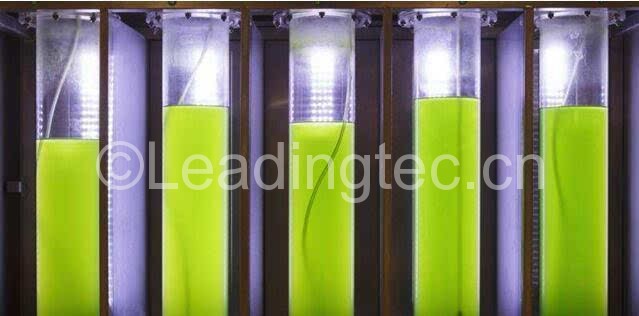藻类生物燃料遇到点烦心事。这种替代燃料能源,和许多生物燃料一样,有助于减少碳排放,而且还不占用粮食生产用地。但是它却被壳牌和埃克森美孚这样的大公司给抛弃了,这些公司正在放弃对这个环境友好燃料的投资。为什么这么有前途的技术没有能够开花结果,我们还能做什么来挽回它呢?

藻类是生长在水中,从二氧化碳和阳光中产生能量的光合生物。单细胞微藻类富含脂肪,可以用来转化成生物柴油,这是最常见的生物燃料。生产生物燃料的原材料有很多种,包括玉米和烹调过的食用油。但是藻类很特别,因为它们生产迅速,能够产生大量的燃料(高生产率)。
在过去的十年中,能源行业已经投入大量的资金用于藻类生物燃料生产的发展。这是非常有意义的,因为,十年前,由于高油价以及人们对碳排放造成气候变化意识在增强,有必要寻找化石燃料的替代品。藻类生物燃料被吹捧为解决这些问题的答案,从而导致了大量投资的跟进。
不幸的是,我们对整个事情缺乏完整的规划。生产藻类生物燃料的企业难以在更大的规模保持其高生产力,而且他们发现肉食动物经常污染他们的农场。他们还发现,这种生产方式并不经济。建造池塘种植藻类以及为它们提供足够的阳光和养分用于生长,代价高昂,雪上加霜的是,石油价格暴跌。
不只是生物燃料
藻类不仅仅能够生产生物燃料。实际上,藻类类似于一个微型工厂,可以生产各种有用的化合物,这些物质可以用来制造一系列不同种类的产品。
例如,藻类能产生大量的ω-3脂肪酸,这是一种重要的膳食补充剂。这意味着它可能是一个可持续的ω-3的植物来源,否则我们只能通过吃鱼或倒胃口的鳕鱼鱼肝油来获取ω-3脂肪酸。更普遍的是,藻类是维生素、矿物质和蛋白质的良好来源,人们经常服用如小球藻、螺旋藻等,因为它们对健康有益。
另一个用途是藻类可以制成生物塑料。普通塑料是一种由化石燃料制成的产品,而且很难降解,不环保。藻类能够以较低的碳排放,甚至在某种程度上能够吸收碳排放的方法来生产生物塑料。藻类的利用有助于防止塑料在环境中的积累。
产品的多样性可能是最后开发藻类生物燃料的关键。这些产品中有很多高价值的化学品,销售价格远远高于生物燃料。因此通过将藻类与生物柴油生产结合,我们可以补贴燃料价格,从而抵消藻类养殖成本高的问题。
这个概念,被称为“生物炼制”,是新一轮的藻类研究,希望能够解决过去十年存在的问题。我们知道炼油厂生产塑料、纤维和润滑油以及燃料。现在我们希望以完全相同的方式开发藻类生物炼制。
藻类生物炼制
为了使这个方法更具成本效益和可持续性,我们需要利用废热、二氧化碳和营养物质供藻类生长。这些物质从发电厂、工厂和水处理厂都很容易获取,这就能够降低一部分藻类生长的成本。藻类燃料生产后,会残留下大量的蛋白质碳水化合物和其它分子。这些物质都可以转化成上文提到的各种产品,或者可以用于生产沼气(另一种燃料来源)。这些沼气可以出售,或者用它们在生物炼制厂中生产藻类所需要的热量,这个闭合回路使整个生产过程更加高效。
我们很容易就可以了解到,这个过程提出了一个可持续的、有利可图的用藻类生产生物燃料的方式。事实上,已经有公司将这一概念应用到具体工作中。在2014年,蓝宝石能源公司,世界上最大的藻类生物技术公司之一,宣布他们正在扩大业务范围,包括营养补充剂以及生物燃料。业务重点向生物炼制方向转移对许多想要丰富产品线的公司来说,已经越来越普遍。
显然,藻类生物炼制还不能解决藻类商业化今天所面对的所有问题。这个行业还面临许多关键问题,藻类大规模生产的效率损失问题,以及藻类培养过程中的污染问题。这些问题只能通过持续的努力研究来解决。生物炼制很可能是人类未来摆脱化石燃料的下一步计划。
英文原文:
Opinion: Can we save the algae biofuel industry?
Algal biofuels are in trouble. This alternative fuel source could help reduce overall carbon emissions without taking land from food production, like many crop-based biofuels do. But several major companies including Shell and ExxonMobil are seemingly abandoning their investments in this environmentally friendly fuel. So why has this promising technology failed to deliver, and what could be done to save it?
Algae are photosynthetic organisms related to plants that grow in water and produce energy from carbon dioxide and sunlight. Single-celled microalgae can be used to produce large amounts of fat, which can be converted into biodiesel, the most common form of biofuel. There are many possible ingredients for making biofuels, from corn to used cooking oil. But algae are particularly interesting because they can be grown rapidly and produce large amounts of fuel relative to the resources used to grow them (high productivity).
In the last decade or so, vast amounts of money have been invested in the development of algae for biofuel production. This made sense because, ten years ago, there was a need to find alternatives to fossil fuels due to the high oil price and the increasing recognition that carbon emissions were causing climate change. Algal biofuels were touted as the answer to these twin problems, and huge investment followed.
Unfortunately, things didn’t go quite to plan. Companies making algal biofuels struggled to retain their high productivity at a larger scale and found predators often contaminated their farms. They also found that the economics just didn’t make sense. Building the ponds in which to grow the algae and providing enough light and nutrients for them to grow proved too expensive, and to make matters worse the oil price has plummeted.
Beyond biofuels
But algae don’t just produce biofuels. In fact, algae are like microscopic factories producing all sorts of useful compounds that can be used to make an amazingly diverse range of products.
For example, algae can produce large amounts of omega-3 fatty acids, an important dietary supplement. This means it could be a sustainable, vegetarian source of omega-3, which is otherwise only available from eating fish or unappetising cod liver tablets. More generally, algae are excellent sources of vitamins, minerals and proteins, with species such as Chlorella and Spirulina commonly being consumed for their health benefits.
Another useful product that can be made from algae is bioplastic. Regular plastic is a product of fossil fuels and takes an extremely long time to break down, which makes it very environmentally unfriendly. Bioplastic from algaecan be produced with low carbon emissions, or even in a way that absorbs emissions. Their use could help prevent the build up of plastic in the environment.
The diversity of these products may be the key to finally developing algal biofuels. Many are high-value chemicals, selling for a much higher price than biofuels. So by combining them with biodiesel production, we could subsidise the price of the fuel and offset the high costs of algal cultivation.
This concept, known as a “biorefinery”, is part of a new wave of algae research that aims to overcome the issues of the past decade or so. We already know that oil refineries produce plastics, fibres and lubricants as well as fuels. Now we are hoping to develop algal biorefineries in exactly the same way.
Producing an algal biorefinery
To make this model cost-effective and sustainable, we would need to use waste sources of heat, carbon dioxide and nutrients to grow the algae. These are widely available from power plants, factories and water treatment plants and so could reduce some of the costs of growing algae. After making algal fuel, you’re left with lots of proteins, carbohydrates and other molecules. These can be converted into the kinds of products mentioned above, or used to produce biogas (another fuel source). This biogas can be sold or used at the biorefinery to produce heat for the algae, closing the loop and making the whole process more efficient.
It’s easy to see how this process could be a way forward for sustainable, profitable biofuel from algae. In fact, there are companies already applying this concept to their work. In 2014 Sapphire Energy, one of the world’s largest algal biotechnology companies, announced that they were diversifying their work to include nutritional supplements as well as biofuels. This move towards biorefinery is becoming more common and many firms diversifying their product lines.
Clearly, the algal biorefinery will not solve all the problems facing commercial algal cultivation today. There are still key issues facing the loss of yield at very large scales, and the contamination of algal cultures by predators that eat your crop of algae. These issues will only be solved by continued research efforts. However, biorefinery may well be the next step towards a future free from fossil fuels.
